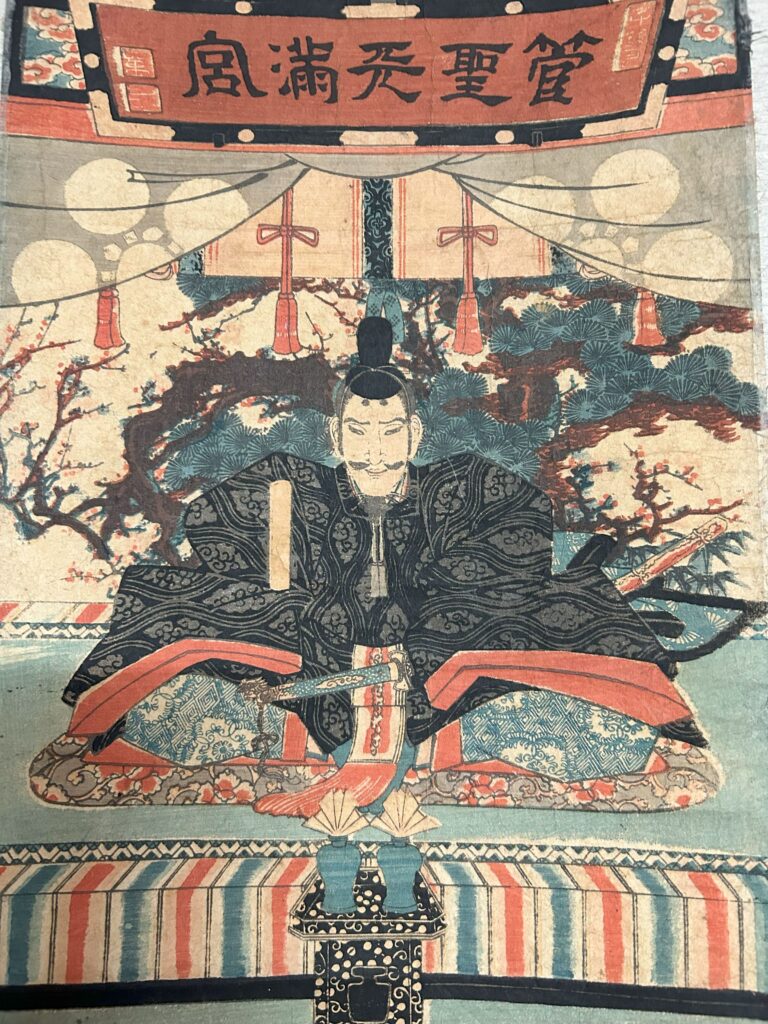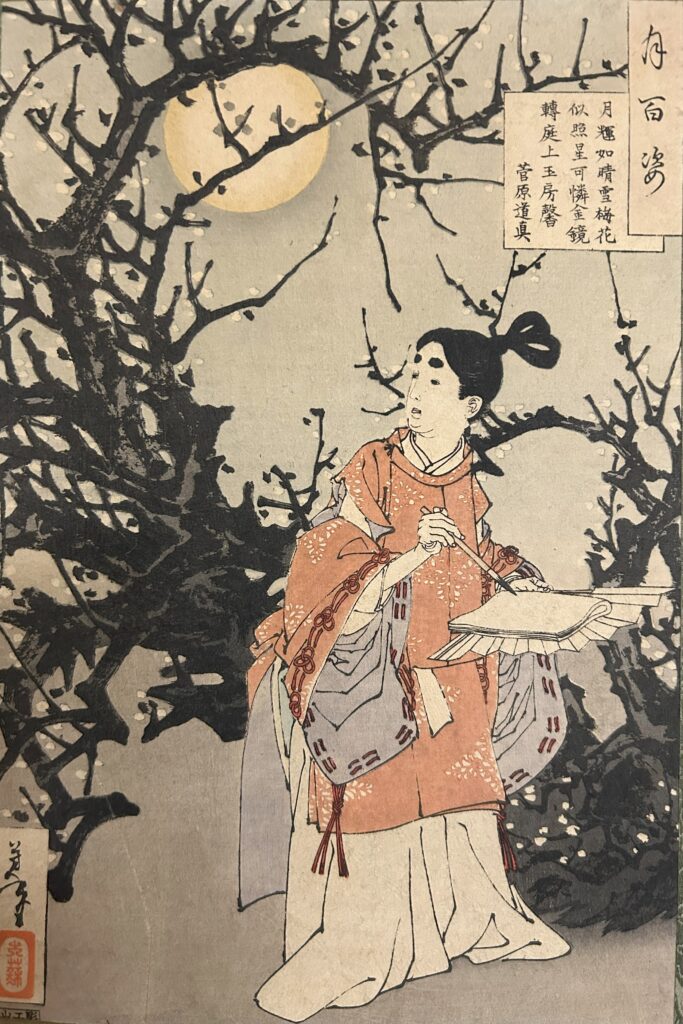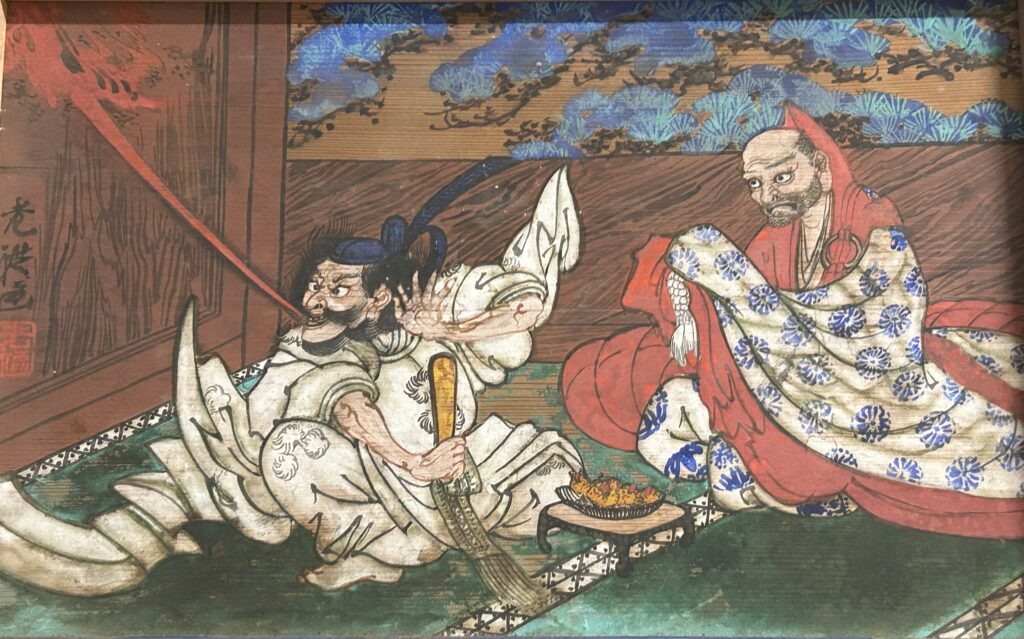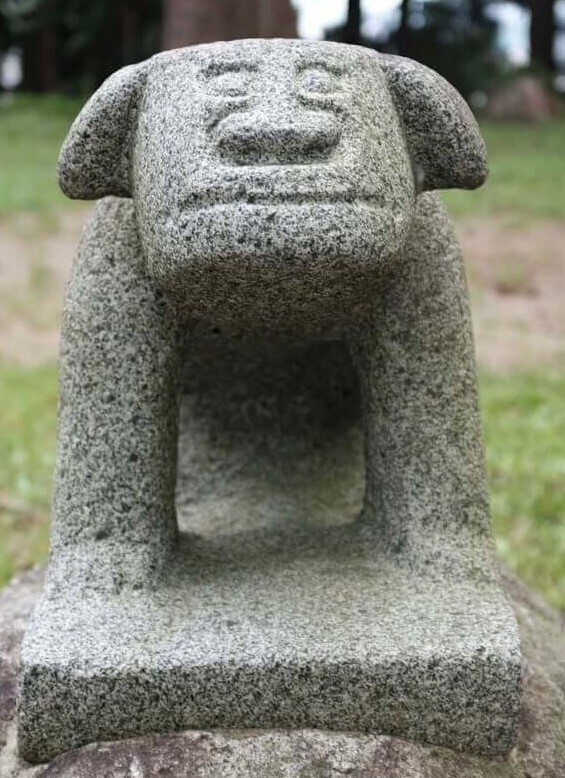1 - About the deity
The father of Japanese culture

Sugawara no Michizane
Deity's name: "Tenman Daijizai Tenjin"
Sugawara no Michizane was born in 845 to a noble family.
From his early youth, Michizane excelled at poetry and writing. Called a child prodigy, he composed a waka poem when just 5 years old.

“The beautiful crimson color of the plum blossoms makes me want to wear them on my face.”
Michizane was known not only for his academics, but also for his skill with the bow, which allowed him to hit a target 100% of the time. He passed the exam to become a monjou-shou – literary apprentice - at the young age of 18. Later, he was able to become a monjou-hakase, the highest rank for a scholar.
When Michizane was 38 years old, his father died, so he began to run the private school that had been passed down to him by the Sugawara family. Many of the scholars he trained were excellent, and the Sugawara family produced many officials in important positions at the imperial court. They would become a major faction of imperial academics. He also demonstrated his abilities as a politician. When he was appointed as the governor of Sanuki Province, he rebuilt the impoverished province and governed well, which earned him the admiration of the people. He was also courageous enough to give advice to Fujiwara no Mototsune, who was nine years older than Michizane. Mototsune would become the first Kampaku - chief adviser to an emperor - in Japanese history. Michizane was a low-ranking aristocrat, but he was well-respected by Emperor Uda as a man of strong character due to his outstanding academic abilities and achievements. In 1251, after only two and a half years as a Sangi - an associate councilor - he surpassed three of his predecessors and achieved the position of Chunagon - a counselor of the second rank in the Imperial court. Two years later, in 1252, he was promoted to the important position of Udaijin - Minister of the Right. Fujiwara no Tokihira, the son of Fujiwara no Mototsune and Sadaijin, Minister of the Left, was wary of Michizane's rise in rank. Fujiwara no Tokihira had Michizane exiled to Dazaifu in Kyushu, accusing him of plotting a rebellion against Emperor Daigo. Furthermore, while en route to Dazaifu, he was not given any food, his post was not treated as an official transfer, and he was subjected to various other harassments and forced to endure a harsh journey with no provisions or clothing. Nevertheless, he prayed sincerely to the heavens for the safety of the Imperial family, peace for the nation, and his own vindication. In 903, Michizane died in despair in Dazaifu. Shortly afterwards, a series of strange incidents occurred in the capital. Natural disasters and epidemics increased, and Fujiwara no Tokihira also died at the young age of 39. Two of Emperor Daigo's crown princes also died in succession, and the Imperial Palace was struck by lightning. The stress caused Emperor Daigo to fall ill, and he passed away. People believed that these strange incidents were the result of Michizane's curse, that his spirit had become a deity and was avenging his grudge, and so they built Kitano Tenmangu Shrine in Kyoto to appease his soul. This story of the curse was later forgotten, and Michizane came to be worshipped as the deity of learning because of his talent for poetry and literature.
“Graphic of Pomegranate Tenjin”

After the death of Sugawara no Michizane, a series of lightning accidents struck the clan of Fujiwara no Tokihira. Their mansions burned down due to lightning, and other strange incidents occurred one after another. The Imperial Court and the Fujiwara clan assumed that this was the vengeful spirit of the late Michizane, and asked Enryaku-ji Temple to soothe his wrath using a secret technique. When Michizane's vengeful spirit heard this, he visited the head priest of Enryaku-ji Temple, Son'i, and asked him to stop praying, to which the head priest replied, “Thank you for coming all the way. I'll ask you to eat a pomegranate.” As soon as the vengeful spirit ate it, it spat it out as flames and burned the sliding door. This represents an intense rage that could not be contained.
“This time/ not even bring any offerings/ at Mt. Tamuke/ a brocade of the red leaves/ to the deities as they wish.”
On this journey, I did not have time to prepare offerings to the deities in hopes of safe travel, so instead, I will leave the beautiful autumn leaves, as the deities wish.
2 - Regarding some background history

When Morioka Castle was first built, the shrine, which was located between Yotsuya and Teramachi, was moved in 1625 to a site by the outside moat near an auxiliary gate to the castle in Kamicho-Kawashimocho. It was again moved to Sasamoriyama in 1666. Because a new Hachimangu Shrine (present-day Morioka Hachimangu Shrine) was constructed, it was moved to its current location at Hanasakadate in Shinjo Village in 1679.
One night in 1646, Otori Shinyu Hogen, the head priest of Anrakuji Temple in Chikushi and grandson of the 28th head of the Sugawara clan, had a dream. He composed the following verse: “The elegant branches of the plum tree flourish in ten places.” He then carved two statues from an old Tobiume tree - the Flying Plum Tree - in Dazaifu. With every single stroke of the chisel, he would bow three times to show his sincere gratitude, and then took them to the Kanto region, where he enshrined one statue at Kameido in Musashino Province (present-day Kameido Tenjin Shrine). In May 1662, he traveled to Rikuchu Province and enshrined the other statue at Tenmangu Shrine (present-day Morioka Tenmangu Shrine) near the Nakatsugawa River. He left it in the care of the head priest Juen before returning to Chikushi.
Michizane was deeply revered by the feudal lords of Morioka, and the local people have been honoring him as a deity of learning, literature, and healing ever since.
3 - About Takuboku Ishikawa and Tenmangu Shrine

Morioka Tenmangu Shrine was Takuboku's walking route. The pair of carved stone guardians (komainu lion-dogs) are now ensconced on top of monuments to Takuboku.
Tenmangu Shrine and the komainu lion-dog guardians appear in Takuboku Ishikawa’s novel “A Funeral Procession.”


